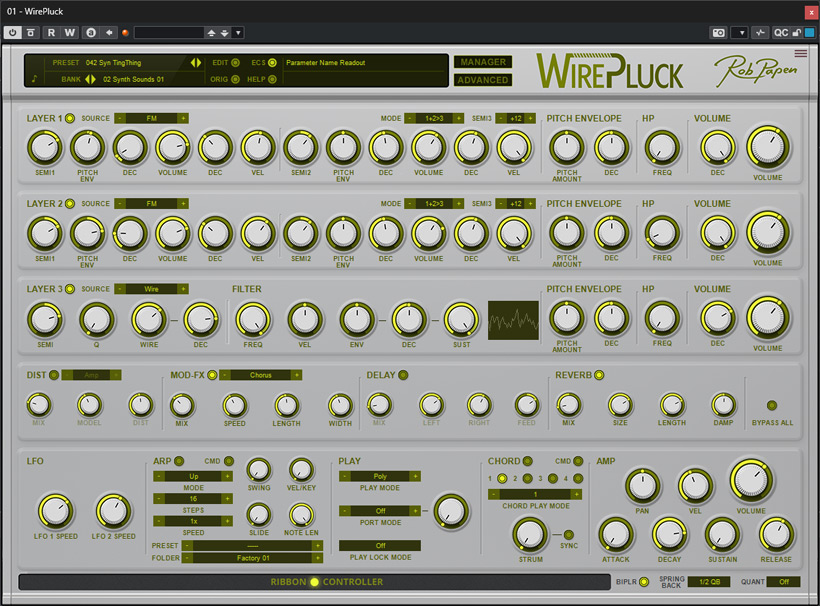Rob Papen eXplorer-10 Bundle
New instruments: RAW 2, SynFexand WirePluck
Author: Peter Kaminski

Rob Papen's synthesizers are already acknowledged classics in the synthesizer scene. His complete bundle eXplorer was released in its tenth edition in March 2025. It includes all of Rob Papen's virtual instruments and effect plug-ins, including the two new instruments RAW2 and SynFex, as well as new presets for synthesizers released earlier.
Requirements and installation
As with previous versions, eXplorer can be installed on both macOS (from 10.15, ARM processor compatible) and Windows-based computers (from Windows 7). Authorization is done through the user account on the Rob Papen website using device IDs. The bundle can be installed on two computers.

The installer allows you to install the individual plug-in formats VST2, VST3, AAX, and AU (for macOS).

The bundle comes with a lot of sound libraries (about 2.4 gigabytes), and it's commendable that you can individually enter the path for the library, so you don't have to use your system partition for it.
RAW-2
Let's start with an old acquaintance in a new form: The virtual synthesizer RAW has been around for over ten years. The idea came from two Dutch EDM producers.
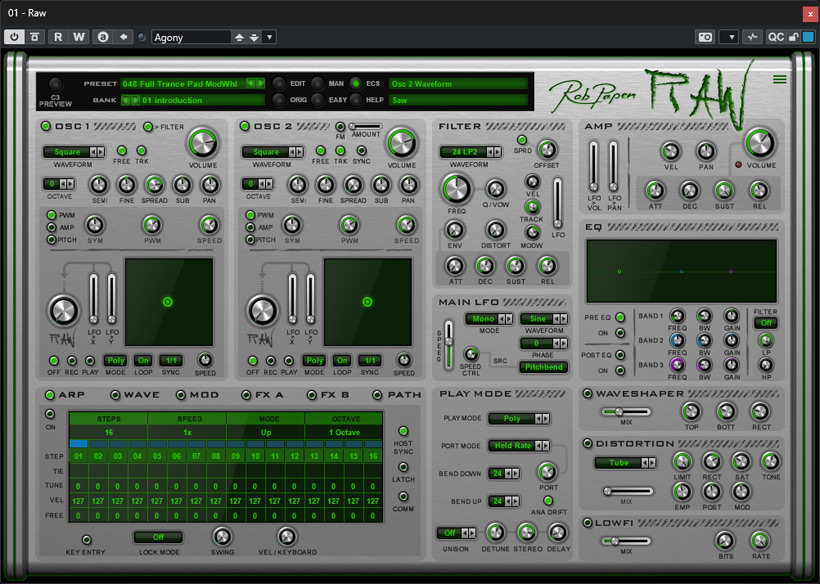
The goal was to create a synthesizer that focuses on hard and distorted sounds - and thus, Rob Papen's RAW development (see figure above) of the first version began.
At first glance, you don't notice that many differences between the new RAW versions (see figure above). For example, the virtual ribbon controller in the lower section is new, along with many technical details. The filters and waveshapers now work on a per-voice synthesis level, making them more flexible, and new effects have been added. More detailed information on this will be provided later in the actual test.
Another new feature is the alternative EASY GUI, which limits the display to the most important parameters (see figure below) and is particularly useful for live performances. But since we have not yet presented the first RAW version, here is the full functionality of RAW-2.

The configuration menu allows you to set global parameters such as the display size and the MIDI parameters (see figure above).
RAW-2 also offers a whole range of new presets, making a total of almost 4,000 presets now available.
As with most other Rob Papen synthesizer products, the preset browser also allows you to search using many different criteria and categories (see figure above).

As before, the oscillator section consists of two identical oscillators with extensive modulation options, each with a sub-oscillator. Phase distortion can be set or modulated using the XY fields. There are four modes: LIVE for real-time influence, REC for recording a process, and Play for playing back a process.
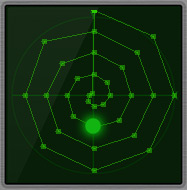
In EDIT mode, points can be created manually and then moved using reference points (see figure above).
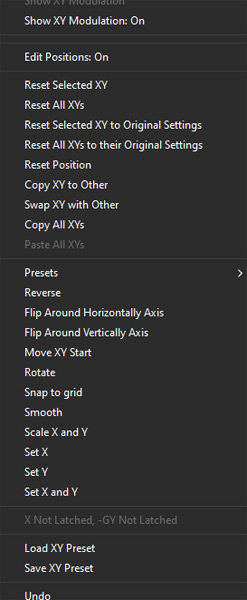
A menu also offers a number of options for retrieving preset curves or for saving or loading presets of curves (see figure above).

In addition to high- and low-pass filters with 6 dB, 18 dB, and 32 dB steepness, there are also six filter types with 12 dB and 24 dB steepness, including multi-filters, as well as more specialized filters such as vocal and formant filters, comp filters, ring modulators, and amplitude modulation. Another section is that of the virtual VCA, which, like the filter, also has an integrated ADSR envelope generator. A special feature are the two parametric three-band equalizers with high-pass/low-pass filters: One EQ before and one after the distortion sections. EQ filters are rarely found on virtual synthesizers, but in combination with the distortion sections, which will be mentioned in a moment, the EQs offer many possibilities for shaping sounds.

Now to the particularly important sections, namely, the three distortion sections. They offer a waveshaper, a distortion unit, and a low-fi section.

The distortion section offers 23 different modes. The low-fi section allows you to change the word length, sample rate, and noise component, and a low-pass filter with an adjustable effect is inserted in the signal path.

The main LFO with different output waveforms and modes (see figure above) is located above the play section.
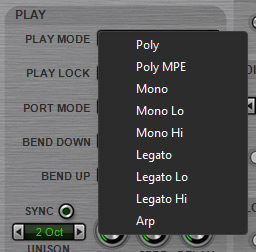
The play section offers various keyboard play modes and also supports MPE.

The possibilities are particularly extensive when the unisono mode is activated. Here, you can choose from a wide range of both stacking and chord modes (see figure above).

An arpeggiator is practically part of the standard equipment of Rob Papen synthesizers, so the RAW-2 also has one in its typical design layout. It can also be used as a 32-step sequencer.

Another page in the lower part of the GUI is, among other things, a waveform editor (see figure above).

The modulation matrix is also in the usual style of Rob Papen's synthesizers, which shortens the familiarization time if you already know other Rob Papen synthesizers. The modulation matrix leaves nothing to be desired, is highly flexible, and also easy to understand in its overview.

An effects section was already present in the first version of RAW. This has now been combined into a single section and also offers additional effect types.

Modulation effects such as chorus, flanger, and phaser are now also on board, along with a stereo delay and reverbs.

A special feature of a synthesizer is that you can change the order or position of the virtual components in the signal chain in the oscillator signal path and in the effect path (see figure above). This can be set on the PATH page.
SynFex
Another new addition is the new synthesizer “SynFex”, which is an effects synthesizer that we would like to introduce here. SynFex can be used to play samples, add noise, and set various modulation sequences. This synthesizer also has an effects section with modulation effects, delay and reverb. SynFex has also been NKS-compatible since April 2025.
Library management is a critical issue for an effects synthesizer, especially with regard to search functions. These are very extensive in all synthesizers in the Rob Papen eXplorer-10 bundle. Approximately 600 effect presets are included.
The top view can also be switched to the sample page (see figure above), where, for example, loop start and end points can be set.
WirePluck
In July 2025, after we published the test, WirePluck was added to the eXplorer-10 bundle as a new synthesizer with 16 voices. We have therefore updated the article. WirePluck offers three layers, and each layer can be assigned to one of four different synthesizer types:
- Wire
- String (Karplus Strong)
- FM (with 3 operators)
- Wave (additive synthesis)
As the name of the synthesizer suggests, the focus is on sounds that simulate strings being plucked or strummed with a pick. The synthesizer also has a number of effects on board, such as chorus, flanger, delay, and reverb, as well as a comprehensive arpeggiator.
Practice
Although the RAW-2 is focused on distorted or hard sounds with extensive modulation options, it is more versatile than it appears at first glance. EDM fans will certainly enjoy the RAW-2, but it can also be used for all types of pop music. The two equalizers that can be looped into the signal path are very useful for fine-tuning the sound of signals rich in harmonics. The number of presets is enormous. The overall concept and interface design fit very well into the range of synthesizers in the eXplorer bundle.
The SynFex, on the other hand, is much more specialized. It is perfectly suited for film and video scoring, making it a valuable tool for film score composers and sound designers. The 600 presets, which are generally not musical but can only be used as effects, are a good starting point for adapting existing presets or creating your own. Many sounds could also be created with other synthesizers, but with the SynFex, many things are easier and much more flexible. Furthermore, there are also many sounds that may exist in a similar form as samples in some sound library, but they cannot be influenced or modulated as much as with the SynFex.
A quick word about the new WirePluck. The sound is much more versatile than the name suggests, and many of the factory presets remind me personally of the PPG Wave 2.0 synthesizer, but more modern. The WirePluck is an absolute asset to the bundle. In terms of operation, it is in line with the other synthesizers in the bundle.
Conclusion
The eXplorer-10 software bundle costs around 500 US$/€ and the upgrade from eXplorer-9 to eXplorer-10 is 74 US$/€. According to the manufacturer, the RAW-2 costs 99 US$/€ on its own, while the SynFex 49 US$/€. The upgrade price makes it worthwhile for existing customers to upgrade in any case, as there are also many new presets for Blue-III and Albino-3 in addition to the two synthesizers. The Rob Papen eXplorer bundle remains an extremely interesting package, especially considering that there are also some delay and effect plug-ins included.
 How to resolve AdBlock issue?
How to resolve AdBlock issue? 






